Abstract
Visible light photocatalytic radical carbonylation has been established as a robust tool for the efficient synthesis of carbonyl-containing compounds. Acyl radicals serve as the key intermediates in these useful transformations and can be generated from the addition of alkyl or aryl radicals to carbon monoxide (CO) or various acyl radical precursors such as aldehydes, carboxylic acids, anhydrides, acyl chlorides or α-keto acids. In this review, we aim to summarize the impact of visible light-induced acyl radical carbonylation reactions on the synthesis of oxygen and nitrogen heterocycles. The discussion is mainly categorized based on different types of acyl radical precursors.
1. Introduction
Carbonyl-containing compounds, such as ketones, esters and amides, widely exist in numerous biologically important natural products, functional materials as well as pharmaceuticals [1,2,3,4,5]. The development of efficient methods toward synthesis of these substantial compounds has been intensively pursued by synthetic chemists over the past decades. Radical carbonylation promoted by transition metals (Pd, Mn, Co, Ni, Ru, Rh etc.), external oxidants or thermal initiation has been well-established for the preparation of carbonyl compounds with high efficiency [6,7,8,9,10,11,12]. Additionally, light-induced radical carbonylation reaction affords an alternative platform for the assembly of carbonyl motifs [13,14,15,16,17]. The pioneering examples are typically mercury and polyoxotungstate-photosensitized alkane carbonylation, metal-carbonyl catalyzed radical carbonylation and radical/Pd-combined carbonylation. Despite these impressive advances, the requirement of high-energy UV irradiation, poor selectivity or low efficiency profoundly limits their broad applications in practical synthesis.
Visible light photoredox catalysis has emerged as one of the most important techniques in radical reactions by employing an abundant and endlessly renewable solar energy as a driving force [18,19,20,21,22,23,24,25,26,27,28,29,30]. Under photocatalytic conditions, various radical species can be formed in a mild and controllable fashion, which enables the precise synthesis of high value-added products. In this context, acyl radicals are commonly generated by the addition of alkyl or aryl radicals to carbon monoxide (CO) or from single electron transfer (SET) conversion of aldehydes, carboxylic acids, anhydrides, acyl chlorides or α-keto acids (Scheme 1) [31]. In this review, we mainly summarize recent advances in the field of visible light-induced radical carbonylative synthesis of oxygen and nitrogen heterocycles with an emphasis on the catalytic system, scope and reaction mechanism. The principal achievements are partitioned into the sections organized based on different acyl radical precursors. Transition metal-catalyzed radical carbonylation and atom transfer radical carbonylation have been comprehensively reviewed before and will not be discussed here [32,33].
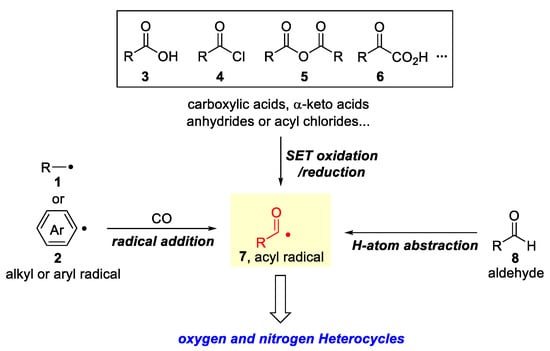
Scheme 1.
Acyl radical carbonylation reactions in the synthesis of heterocycles.
2. Carbon Monoxide (CO)-Mediated Radical Carbonylation
Carbon monoxide (CO), as a cheap and readily available carbonyl source, has been extensively used in radical carbonylations [34,35]. In 2014, Xiao and colleagues reported a visible light-induced photocatalytic alkoxycarboxylation of aryldiazonium salts with alcohols under the CO pressure of 80 atm (Scheme 2) [36]. A range of structurally diverse benzoates was obtained in moderated to good yields. Notably, natural chiral alcohols such as N-benzoyl L-(+)-prolinol, (-)-menthol and methyl D-(-)-mandelate were compatible with this carbonylation reaction. When ortho-allyl- or ortho-propargyl-substituted benzenediazoniums were used, the resultant dihydrobenzofuran 11d and benzofuran 11e were formed in 63% and 58% yields, respectively. Almost at the same time, the group of Wangelin achieved the same reaction using eosin Y as a cheap photosensitizer [37]. Importantly, a lower pressure of CO (50 atm) was sufficient in this reaction. These two findings opened new avenues for the development of radical carboxylation reactions.
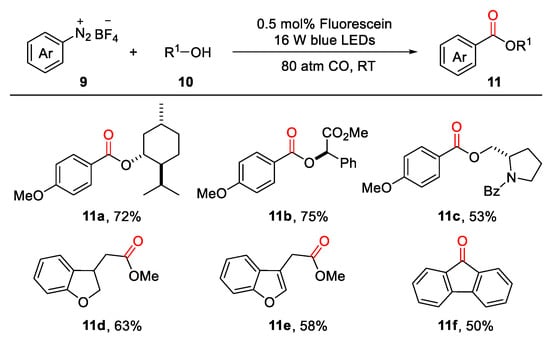
Scheme 2.
Alkoxycarboxylation of aryldiazonium salts with alcohols.
It is believed that a visible light-induced radical carbonylation pathway would be involved in this reaction, as accounted for by control experiments and density functional theory (DFT) calculations (Scheme 3). Upon irradiation with blue LEDs, the photocatalyst PC initially undergoes a photoexcitation process to give a long-lived excited species PC*. Then, a single-electron reduction of aryldiazonium salt 9 by PC* produces the intended aryl radical intermediate 9-A. Thereafter, radical 9-A is rapidly trapped by CO to generate the key acyl radical 9-B, which can be easily oxidized by PC+ to achieve the benzylidyneoxonium 9-C, thus completing the photocatalytic cycle. Subsequently, the electronic trapping of 9-C by alcohols results in the benzoate products.
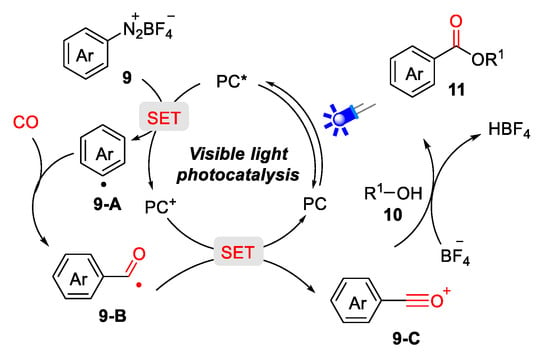
Scheme 3.
A plausible mechanism for the alkoxycarboxylation of aryldiazonium salts.
Later, Gu et al. used (hetero) arenes as electrophiles to trap the reactive benzylidyneoxonium intermediates, delivering aryl ketones in moderate yields [38]. Generally, the electron-rich arenes gave better results over electron-deficient substrates, and nitrobenzene failed to give the expected product in the current system. In 2016, Li et al. further extended this strategy to the carbonylation of indoles for the preparation of various indol-3-yl aryl ketones [39]. In addition, by employing readily available arylsulfonyl chlorides as a robust source of aryl radicals, Liang, Li and co-workers achieved the same reaction under a 80 atm CO atmosphere with irradiation by green LEDs [40].
In 2018, a visible light-induced annulative carbonylation of alkenyl-tethered aryldiazonium salts was developed by Polyzos et al. in continuous-flow (Scheme 4) [41]. Under a moderate CO pressure (25 atm), this reaction proceeded smoothly to afford a range of 3-acetate substituted 2,3-dihydrobenzofurans 14 in satisfactory yields with excellent chemo- and regio-selectivity. Moreover, the generality of this transformation can be further extended to the reaction of unsaturated ortho-tethered aryldiazonium salts. When 1-butenyloxy- and propargyloxy-substituted aryldiazonium salts were subjected to the optimal conditions, the acetate-functionalized chromane 14f and benzofuran 14e were successfully obtained in 72% and 57% yields, respectively. It should be noted that the current continuous-flow protocol drastically shortens the reaction time to 200 s, which enables a preparative scale-up reaction in high efficiency.
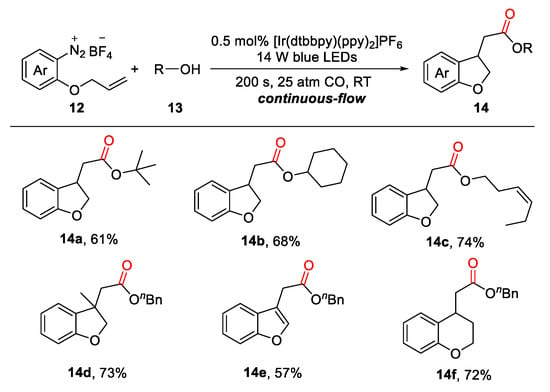
Scheme 4.
Annulative carbonylation of alkenyltethered aryldiazonium salts.
In 2015, Xiao and Lu et al. reported an elegant decarboxylative/carbonylative alkynylation of carboxylic acids (Scheme 5a) [42]. Remarkable features of this transformation include mild conditions and high efficiency. The synthetic utility of this methodology was demonstrated by the success of a rapid solar light-driven reaction and 5.0 mmol gram-scale reaction. Unlike the well-established Heck reactions of alkenyl and aryl substrates, the alkyl-Heck reaction is still problematic due to the inherent difficulty in palladium-mediated oxidative addition of electrophilic alkyl reagents and competitive β-hydrogen elimination of the generated alkyl–palladium species. Very recently, Xiao and Lu et al. further disclosed a novel deaminative alkyl-Heck-type reaction by replacing palladium-catalyzed two-electron pathway with a photocatalytic single-electron activation [43]. Katritzky salts acted as the alkyl radical sources in this reaction, which can be easily synthesized from structurally diverse alkyl amines [44,45,46]. The choice of bases is critical in this reaction and 1,4-diazabicyclo[2.2.2]octane turned out to be the optimal base. Moreover, under a CO pressure of 80 atm, a photostimulated deaminative/carbonylative Heck-type procedure was developed for the construction of α,β-unsaturated ketones in moderate to excellent yields (Scheme 5b). This radical-mediated alkyl-Heck-type protocol provides a new approach to the libraries of alkenes, complementing the current late-stage of palladium-catalyzed Heck reactions. As illustrated in Scheme 5b, under irradiation with blue LEDs, the excited state Ir(III)* is quickly quenched by Katritzky salt 18 to give a reactive alkyl radical 18-A along with the formation of Ir(IV)-catalyst. The subsequent reaction of alkyl radical 18-A with CO produces an acyl radical 18-B, which then reacts with an alkene to give radical species 19-A. Finally, the SET oxidation of 19-A by Ir(IV)-catalyst affords intermediate 19-B, which undergoes a deprotonation process to give the final enone product.
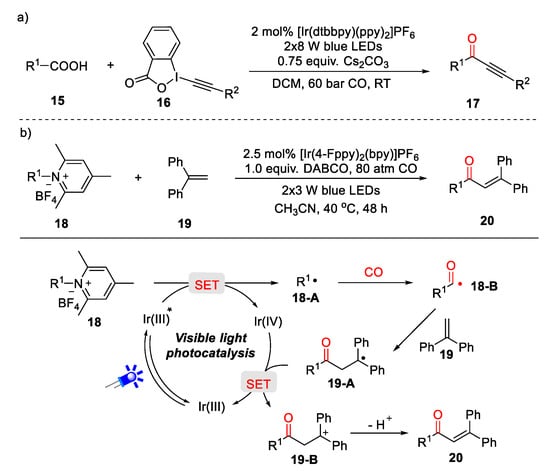
Scheme 5.
(a) Decarboxylative/carbonylative alkynylation of carboxylic acids; (b) Photostimulated deaminative alkyl-Heck-type reaction.
A novel photocatalytic aminocarbonylation of cycloketone oxime esters with amines has been discovered by Xiao and Chen (Scheme 6) [47]. The reactive Cu(I) complex derived from CuCl catalyst and N, N, N-tridentate ligand worked as both visible light photocatalyst and carbonylation catalyst in this reaction. Control experiments suggested the necessity of a copper catalyst, ligand and visible light irradiation. Under the standard conditions, a variety of (hetero)aryl amines and alkyl amines reacted with cycloketone oxime esters, yielding the structurally different aminocarbonylation products in moderate to good yields (Scheme 6a). Importantly, the pharmaceutical agent (±)-mexiletine can be converted in this reaction, highlighting the synthetic potential of this methodology. This reaction provides a direct access to diverse cyanoalkylated amides at ambient temperature.

Scheme 6.
(a) Aminocarbonylation of oxime esters; (b) Proposed mechanism.
According to the mechanistic studies and literature precedents, two reaction pathways have been proposed by authors (Scheme 6b). Under blue-light irradiation, a single-electron reduction of cycloketone oxime ester 21 by the photoexcited state of LnCu(I)–NHPh complex 22-A* (path A) is observed, delivering an iminyl radical intermediate 21-A. In addition, the cycloketone oxime ester 21 can be also reduced by the ground state of Cu(I)/Ln catalyst 22-A due to its redox reactivity (path B). Then, a fast β−C–C bond cleavage of 21-A leads to the cyanoalkyl radical intermediate 21-B, which can react with Cu(II)-catalyst to generate a high-valent Cu(III) complex 21-C. The insertion of a CO molecule into Cu(III)–C bond affords the intermediate 21-D. Finally, the reductive elimination of 21-D gives rise to the amide product 23 with the regeneration of Cu(I)-catalyst for the next catalytic cycle.
Very recently, Arndtsen et al. developed an elegant carbonylative coupling reaction of aryl or alkyl halides with some challenging nucleophiles [48]. The active catalysts of this transformation were believed to be the photoexcited state of Pd(0) and Pd(II) species, which can promote the oxidative addition and reductive elimination steps with low energy barriers (Scheme 7a). It was found that the addition of a visible light photocatalyst was not necessary for this reaction. However, in the absence of blue-light irradiation, palladium catalyst or phosphine ligand (DPEphos), no reaction has been observed. A range of nucleophiles such as sterically hindered secondary amines, tertiary alcohols, substituted anilines and even weakly nucleophilic N-heterocycles can be coupled at ambient temperature, producing various important esters, amides and ketones.
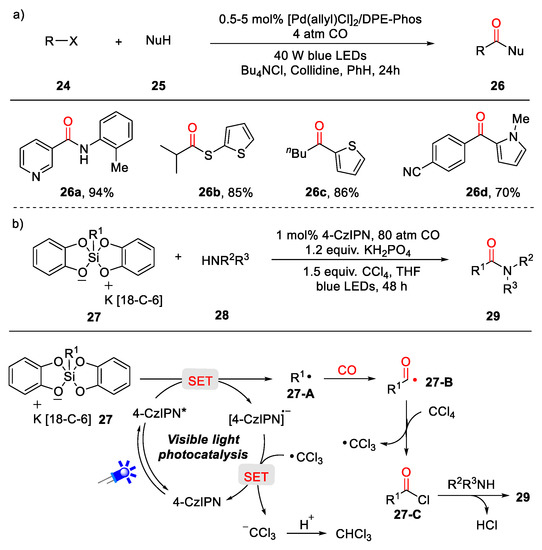
Scheme 7.
(a) Radical carbonylation of halides; (b) Radical carbonylation of organosilicates.
By using organosilicates as alkyl radical precursors, Fensterbank, Ryu, Ollivier and Fukuyama et al. demonstrated a radical carbonylation of various amines for the construction of aliphatic amides under 80 atm pressure of CO (Scheme 7b) [49]. In this reaction, CCl4 acted as a Cl-atom donor to react with acyl radicals for the in situ formation of acyl chlorides, which then reacted with amines to produce amide products. CBrCl3 was also suitable for this process, albeit with a lower yield. The pressure of CO has a pronounced effect on this reaction. When a lower CO pressure of 40 atm was used, the chemical yield was significantly decreased. This strategy can be further applied in an intramolecular carbonylation reaction, leading to pyrrolidinone as the sole product. A plausible mechanism is described in Scheme 7b. Under the irradiation by blue LEDs, the excitation of photocatalyst 4-CzIPN delivers 4-CzIPN*, which initially reacts with organosilicate 27 to give an alkyl radical 27-A via an oxidative Si–C bond cleavage. The addition of radical 27-A to CO results in an acyl radical 27-B, which then abstracts a chlorine atom from CCl4 to generate acyl chloride 27-C and trichloromethyl radical. Acyl chloride 27-C is rapidly trapped by amines to give the amide products. The in situ formed trichloromethyl radical can regenerate the photocatalyst 4-CzIPN through a single electron-transfer process.
Transition metal-catalyzed oxidative carbonylation provides an effective and general platform for the construction of carbonyl compounds [6]. In this type of reactions, a stoichiometric amount of external oxidants is often required for the recyclization of the active Pd(II)-catalyst. Taking the advantage of the fact that O2 is a green and powerful oxidant, the group of Lei achieved a novel O2-mediated oxidative carbonylation of enamides by merging photoredox catalysis and palladium catalysis under a low CO pressure (Scheme 8a) [50]. It should be noted that the usage of 8 mol% xantphos can chiefly improve yields of the desired products. 31P NMR experiments suggested that the phosphine ligand would be firstly converted into its oxidized species, thus facilitating the oxidative carbonylation process. This dual catalytic system affords an environmentally benign access to 1,3-oxazin-6-ones.
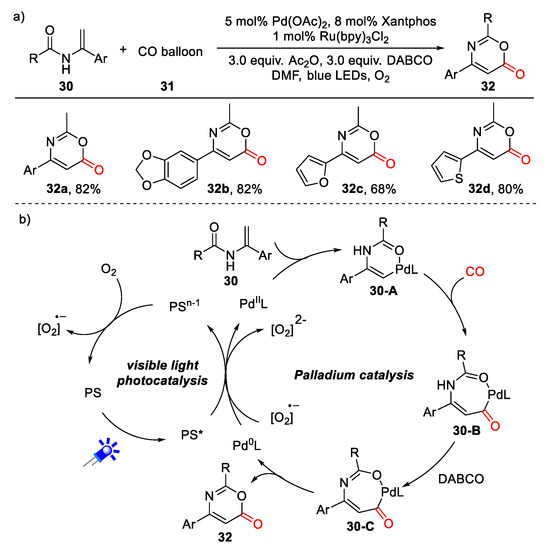
Scheme 8.
(a) Oxidative carbonylation of enamides; (b) Proposed mechanism.
As described in Scheme 8b, the vinylpalladium intermediate 30-A is firstly generated from enamide via Pd(OAc)2-promoted C(sp2)–H bond activation of enamides. Then, the coordination and insertion of a CO molecule into intermediate 30-A produce acylpalladium complex 30-B, which can be transferred into 30-C in the presence of 1,4-diazabicyclo[2.2.2]octane (DABCO). Reductive elimination of 30-C delivers the final carbonylation product 32 with the formation of Pd(0)-catalyst. The Pd(0)-catalyst can be further oxidized by the photoexcited state of photocatalyst or superoxide anion to the active Pd(II)-catalyst, thus completing the palladium catalytic cycle.
3. Aldehyde-Mediated Radical Carbonylation
Aldehydes have been served as versatile building blocks in organic synthesis for a long time. In the presence of hydrogen atom transfer (HAT), reagents such as persulfates, tert-butyl hydroperoxide (TBHP), quinuclidine and Eosin Y, aldehydes can be easily converted into acyl radical species through a rapid HAT [31,51]. In this section, we mainly discuss the acyl radical reactions of aldehydes for the assembly of oxygen and nitrogen heterocycles. In 2014, Zeng and Xie et al. reported an interesting benzaldehyde-mediated Minisci reaction for the regiospecific acylation of biologically important phenanthridines (Scheme 9) [52]. In this reaction, 2.0 equivalent of (NH4)2S2O8 was used as the HAT reagent as well as the external oxidant. This catalytic system is especially well-adapted for aromatic aldehydes, giving 6-acylated phenanthridines in moderate yields.
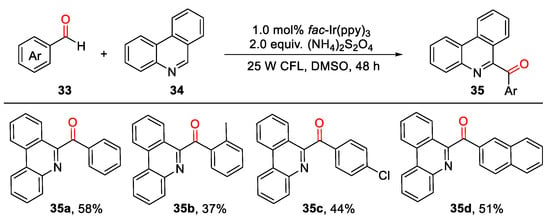
Scheme 9.
Benzaldehyde-mediated regiospecific acylation of phenanthridines.
As an attractive alternative to persulfates, the cheap and readily available TBHP can be also used as a good HAT reagent [53]. In 2015, Wang and co-workers independently published an acyl radical-mediated cascade reaction of benzaldehydes and styrenes for the synthesis of α, β-epoxy ketones (Scheme 10) [54]. TBHP was identified to be superior over other traditional oxidants such as K2S2O8, benzoyl peroxide (BPO) and (t-BuO)2. Various styrenes bearing electron-donating and -withdrawing groups performed well, providing α, β-epoxy ketones in generally good yields. Notably, both 1,1-disubstituted alkenes and pentafluorinated alkenes were compatible with this catalytic system. Significantly, this reaction can be easily scaled up for a gram-scale ketone synthesis.
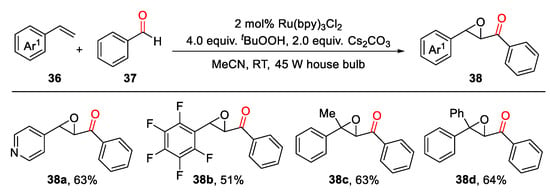
Scheme 10.
Acyl radical-mediated cascade reaction of benzaldehydes and styrenes.
Mechanistic studies by radical trapping experiments and analysis of the reaction mixture by high-resolution mass spectroscopy (HRMS) suggested a plausible acyl radical pathway (Scheme 11). At first, an oxidative quenching of the photoexcited Ru2+* complex by TBHP gives a tert-butoxy radical, which subsequently abstracts a H-atom from benzaldehyde to form the key acyl radical 37-A. Secondly, the selective addition of radical 37-A to alkene 36 results in a new C-based radical intermediate 36-A. At the same time, the oxidation of tert-butyl peroxide anion by oxidizing Ru3+ complex affords tert-butyl peroxide radical and regenerates the ground state of Ru2+ catalyst. The rapid radical coupling of t-BuOO• with 36-A delivers β-peroxy ketone 36-B, which can be detected by HRMS analysis. Finally, under basic conditions, 36-B undergoes a cyclization process to generate the desired α, β-epoxy ketone product with the elimination of tBuOH.

Scheme 11.
Proposed pathway for the radical cascade reaction of benzaldehydes and styrenes.
The group of Salles Jr achieved the same reaction in water with the use of persulfate K2S2O8 as the oxidant and methylene blue as the organophotoredox catalyst (Scheme 12) [55]. It is noteworthy that O2 in water plays an important role in this transformation. Lower yields were observed when reactions were conducted in the degassed water or under N2 atmosphere. Two different types of reactions have been developed, employing only one set of reagents. When styrenes were used as radical acceptors, a visible light-induced epoxyacylation reaction was accomplished. Both aromatic and aliphatic aldehydes were smoothly converted into various epoxyketones in good yields. Interestingly, when nonconjugated olefins were used, the reaction underwent a direct hydroacylation process to form long-chain ketones. In this hydroacylation reaction, only aromatic aldehydes were tolerated. In 2020, the group of Kokotos developed an acyl radical-mediated hydroacylation reaction of alkenes from simple aldehydes under metal-free conditions [56]. Using 4-acyl-1,4-dihydropyridines as acyl radical sources, Xia et al. reported an interesting visible light-induced hydroacylation of alkenes under photocatalyst-free conditions. Additionally, in the presence of a Ni(II)-catalyst, the diacylation reaction was developed [57]. Moreover, Melchiorre et al. achieved an asymmetric acylation reaction of enals for the stereocontrolled construction of 1,4-dicarbonyl products [58].

Scheme 12.
Visible light-induced acyl radical epoxyacylation of olefins.
Using the same strategy, in 2017, Hong’s group reported an acyl radical-mediated intramolecular epoxyacylation reaction catalyzed by Ru(bpy)3Cl2 (Scheme 13a) [59]. The investigation of optimum reaction conditions revealed that TBHP was the best HAT reagent. Under optimal conditions, various spiroepoxy chroman-4-one scaffolds and spiroepoxy enaminones could be constructed in moderate yields. The utility was demonstrated by mild conditions, simple operation and broad substrate scope. In addition, the applicability of this transformation can be further extended to the epoxyacylation of benzylic alcohols, albeit with relatively lower yields (Scheme 13b). In the tandem reaction of benzylic alcohols, 8.0 equivalent of TBHP was required for the in situ formation of benzaldehyde intermediates. This transformation is initiated by the generation of an aldehyde that undergoes a sequential H-atom transfer, intramolecular radical cyclization and epoxidation process to produce the final products.
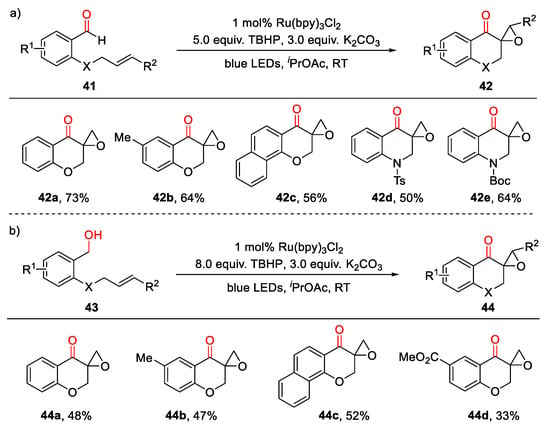
Scheme 13.
(a) Intramolecular radical cylization/epoxyacylation of olefins; (b) Epoxyacylation of benzylic alcohols.
In 2018, Itoh and co-workers described an acyl radical-mediated addition/cyclization cascade reaction of ynoates with simple aldehydes by employing benzoyl peroxide (BPO) as the external oxidant and 2-tert-butylanthraquinone (2-tBu-AQN) as the photocatalyst (Scheme 14a) [60]. More than 20 coumarin derivatives can be synthesized in high efficiency, along with excellent regioselectivity. Notably, it was found that many of coumarin products have good antiproliferative activities against prostate cancer cells. The group of Klussmann developed a facile acyl radical difunctionalization of styrenes with the use of indoles and benzotriazole as nucleophiles (Scheme 14b) [61]. Very recently, a visible light photocatalytic deuteration of formyl groups was achieved by Wang et al. via the acyl radical-mediated H/D exchange strategy [62].
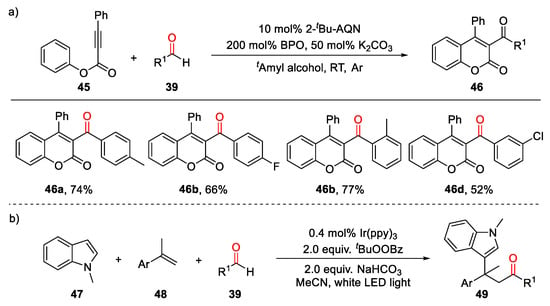
Scheme 14.
(a) Acyl radical cascade reactions of ynoates; (b) Acyl radical difunctionalization of styrenes.
In addition, acyl radical-mediated alkynylation, arylation, vinylation and alkylation have been well-developed over the past 10 years. This has been reviewed by Ngai [31] and will not be discussed here.
4. Carboxylic Acids and Their Derivative-Mediated Radical Carbonylation
Carboxylic acids and their derivatives are promising chemical feedstocks in organic synthesis, and can be easily obtained in great structural diversity both from natural sources and some well-established methods [63,64,65]. Over the past decades, transition-metal catalyzed two-electron decarboxylative conversions of carboxylic acids have been well investigated toward a wide variety of valuable compounds. Recently, a visible light-driven single-electron transfer strategy has provided an important and new platform for the functionalizations of carboxylic acids and their derivatives. In this context, carboxylic acids and their derivatives can be selectively converted to acyl radicals for the preparation of carbonyl-containing compounds and various heterocycles [66].
The direct conversion of carboxylate groups into acyl radicals is relatively challenging due to their high bond strength (102 kcal/mol). In 2018, Zhu, Xie and co-workers developed a convenient deoxygenative activation of carboxylic acids for the hydroacylation of alkenes by using triphenylphosphine (Ph3P) as the oxygen transfer reagent (Scheme 15a) [67]. Taking advantage of the strong P–O affinity between the Ph3P radical cation and carboxylate anion, the homolytic cleavage of C–O bonds can be achieved to generate acyl radicals under mild photocatalytic conditions. Under the standard conditions, various aromatic acids were well-tolerated, while aliphatic acids proved to be unsuitable for this reaction. In addition, the intramolecular radical cyclization reactions were also investigated to synthesize cyclophane-braced macrocycloketones. Moreover, this methodology can be applied for the 3-step concise construction of the drug zolpidem.
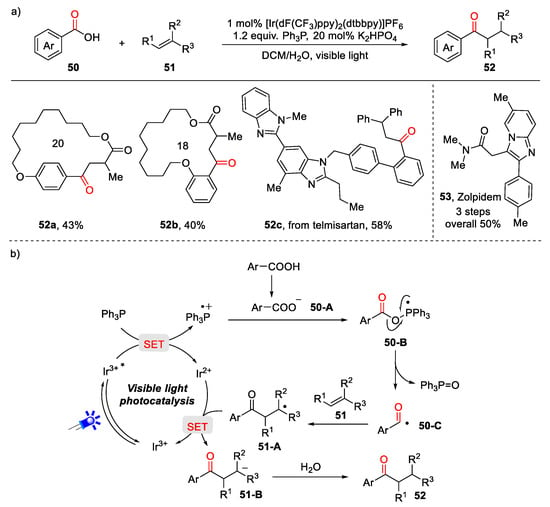
Scheme 15.
(a) Photoinduced deoxygenative activation of carboxylic acids; (b) Proposed mechanism.
The reactions were completely inhibited by radical inhibitors such as 2,6-di-tert-butyl-p-cresol (BHT) and 2,2,6,6-tetramethyl-1-piperidyloxy (TEMPO). To further verify the origin of O-atom in the byproduct Ph3P=O, 18O-labeling experiments were investigated, suggesting that the O-atom of Ph3P=O would come from benzoic acids rather than from water. Taking together, a plausible acyl radical mechanism is illustrated in Scheme 15b. Under blue-light irradiation, Ph3P is initially oxidized by the excited state of photocatalyst *IrIII to generate Ph3P radical cation. The rapid combination of Ph3P radical cation with carboxylate anion 50-A forms the phosphoranyl radical intermediate 50-B. This intermediate undergoes a fast β-scission fragmentation and delivers acyl radical 50-C, which then reacts with alkene to give C-radical 51-A. A SET reduction of C-radical 51-A by IrII-catalyst results in an anion intermediate 51-B, followed by a protonation process to produce the ketone product 52.
Almost simultaneously, Doyle and Rovis et al. applied this synthetic strategy in the general deoxygenative reduction of carboxylic acids via photoredox catalysis (Scheme 16a) [68]. Remarkably, both aromatic and aliphatic acids could be selectively converted to aldehydes by careful modification of the phosphine reagent. Ph3P has been identified as a good oxygen transfer reagent for the deoxygenation of aromatic acids, while it was ineffective for the aliphatic acids. It is believed that a more electron-rich phosphoranyl radical species can be formed from Ph3P and aliphatic carboxylic acid, which may undergo a rapid oxidation process to generate a reactive phosphonium intermediate for the acyl transfer reactions. As a result, an electron-deficient Ph2POEt was selected as an optimal reductant for the reduction of aliphatic acids. Particularly, this method also enables conversions of carboxylic acids into cyclic ketones and lactones via intramolecular cyclization reactions of acyl radicals. More importantly, this strategy can be further applied in deoxygenative reduction of benzylic alcohols.
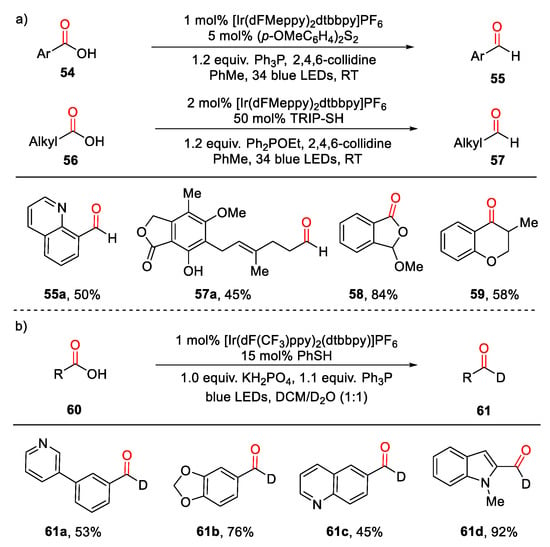
Scheme 16.
(a) Photocatalytic deoxygenative reduction of carboxylic acids; (b) Deoxygenative deuteration of carboxylic acids.
After that, Xie et al. reported a novel deoxygenative deuteration of carboxylic acids by employing inexpensive D2O as the deuterium source (Scheme 16b) [69]. The usage of a thiol catalyst significantly affects this transformation, which may act as a HAT catalyst to tune the equilibrium with D2O, thus facilitating the formation of deuterated aldehydes. Both aromatic and aliphatic acids were conveniently reduced, delivering deuterated aldehydes in moderate yields with high levels of D-incorporation. The robustness of this methodology was demonstrated by the deuteration of biologically important pharmaceuticals and natural products as well as the downstream construction of D-labeled N-containing heterocycles. In a subsequent investigation, in 2019, Zhu, Xie and co-workers disclosed an interesting deoxygenative arylation of aryl carboxylic acids for the preparation of a broad range of unsymmetrical ketones via a visible light-induced 1,5-aryl migration process [70].
By using the same concept, Chu and Sun et al. achieved an elegant acyl radical-mediated intramolecular cyclization of aromatic acids for the preparation of various dibenzocycloketones (Scheme 17) [71]. Methylene blue was the optimal photocatalyst and O2 as a green oxidant. A range of dibenzocycloketone derivatives were produced in good yields under metal-free conditions. Shortly thereafter, an intermolecular hydroacylation of styrenes was discovered by Doyle’s group, affording various dialkyl ketone products [72]. The key to the success of this protocol was the rational selection of a phosphine reagent for the generation of acyl radicals. The electron-rich PMe2Ph with a low oxidation potential was the best choice, which could outcompete the side reactions of alkene substrates. In 2020, Wang and co-workers disclosed a convenient deoxygenation/defluorination cascade reaction for the assembly of γ, γ-difluoroallylic ketones from α-trifluoromethyl alkenes and aryl carboxylic acids. Phenylacetic acids were also tolerated well, while other simple aliphatic carboxylic acids were not compatible with this reaction system [73].
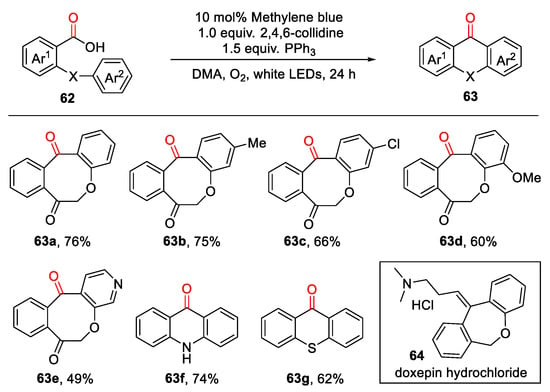
Scheme 17.
Acyl radical-mediated intramolecular cyclization of aromatic acids.
The in situ generated anhydride from carboxylic acid could be engaged as an effective acyl radical precursor. In 2015, the group of Wallentin developed an interesting acylarylation cascade reaction of aromatic carboxylic acids and methacrylamides for the preparation of structurally diverse 3, 3-disubstituted 2-oxindoles (Scheme 18a) [74]. The transient anhydrides were believed to be formed from carboxylic acids and dimethyl dicarbonate (DMDC). The choice of visible light photocatalyst plays an important role in this reaction, and only strongly reducing fac-Ir(ppy)3 can efficiently promote this transformation. For electron-rich benzoic acids, the increase in catalyst loading and reaction time were usually required due to their relatively low reactivity. Under optimal conditions, a wide range of 3, 3-disubstituted 2-oxindoles was obtained in a mild manner. The synthetic value was described by the straightforward synthesis of hexahydropyrrolo[2,3-b]indole unit 66e, which exists widely in many natural products. Similar strategies have been further applied in the hydroacylation of alkenes, reduction of carboxylic acids and deoxygenative radical cyclization [75,76,77,78].
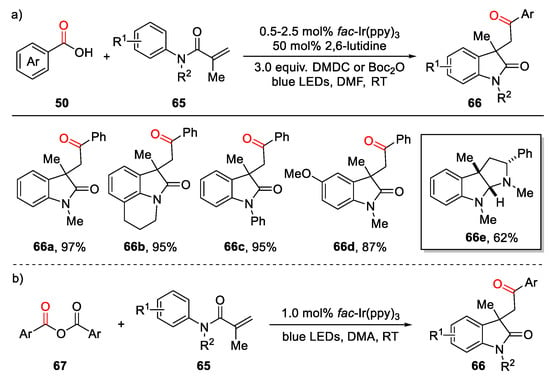
Scheme 18.
(a) Acylarylation reaction of aromatic carboxylic acids and methacrylamides; (b) Acyl radical-mediated difunctionalization of olefins.
Rather than the use of in situ formed anhydride intermediates, Wallentin and co-workers directly employed symmetric anhydrides as acyl radical precursors for the difunctionalization of olefins (Scheme 18b) [79]. Two different types of reactions have been developed, including radical acylarylation of N-arylacrylamides and acylation/semipinacol rearrangement of allylic alcohol derivatives. This protocol has been established as a powerful entry to the construction of oxindoles and 1,4-diketones under mild conditions.
A plausible acyl radical addition/intramolecular cyclization mechanism is proposed. In the presence of 2,6-lutidine, the in situ generation of an anhydride intermediate was achieved from benzoic acid and dimethyl dicarbonate (DMDC), which can be reduced by the photoexcited IrIII*-catalyst (E1/2 (IrIV/*IrIII) = −1.73V vs SCE) to form the key acyl radical 50-C (Scheme 19). Subsequently, the radical 50-C selectively reacts with olefin 65 to give a C-radical intermediate 65-A. Finally, the radical 65-A undergoes a single-electron oxidation and aromatization sequence, producing the oxindole products 66 along with the ground-state of the photocatalyst.
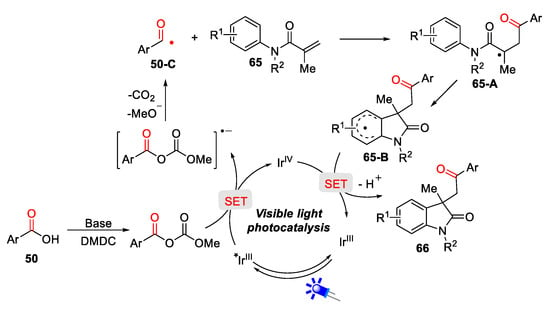
Scheme 19.
Plausible mechanism for the acyl radical-mediated acylarylation reaction.
In addition, acyl thioesters are readily available and could be served as a source of acyl radicals. The group of Gryko discovered an unprecedented vitamin B12-catalysed Giese-type acylation of electron-deficient olefins by using 2-S-pyridyl thioesters as acyl radical precursors [80]. An indirect approach to generate acyl radicals from thioesters has been developed by McErlean and co-workers (Scheme 20) [81]. This reaction avoids the use of organo-tin reagent and high-energy UV light irradiation. Under mild photocatalytic conditions, diverse chromanones and indanone derivatives can be synthesized in moderate yields. The synthesis of clinical agent donepezil 72 further demonstrates the potential utility of this reaction.
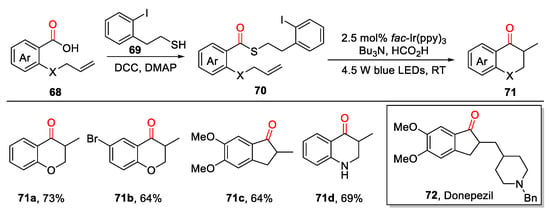
Scheme 20.
Acyl thioesters-mediated acyl radical intramolecular cylization reaction.
Acyl chlorides are abundant and highly active acyl radical precursors. In 2017, Xu et al. developed a radical cascade reaction of N-methyl-N-phenylmethacrylamides with aroyl chlorides for the synthesis of various quaternary 3,3-dialkyl 2-oxindole derivatives (Scheme 21a) [82]. In this reaction, aliphatic acyl chlorides have been unsuccessful substrates due to their low reduction potentials. The same group further expanded this concept to the cascade reaction of 1,7-enynes with aroyl chlorides, providing various fused pyran derivatives (Scheme 21b) [83]. This reaction could be scaled up to 4 mmol, albeit with a slightly lower yield.
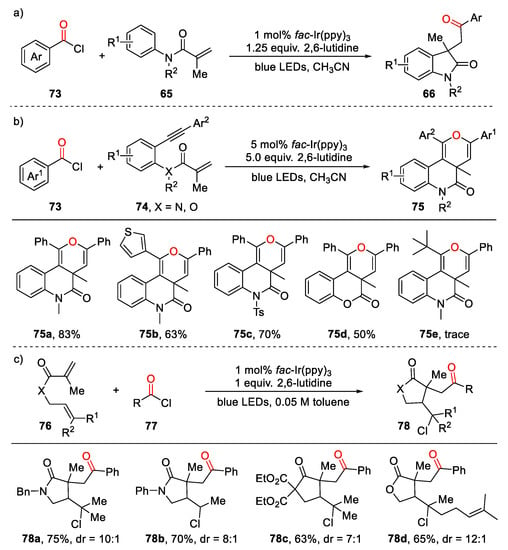
Scheme 21.
(a) Visible light photocatalytic cascade reaction of N-methyl-N-phenylmethacrylamides with aroyl chlorides; (b) Cascade reaction of 1,7-enynes with aroyl chlorides; (c) Aroylchlorination reaction of 1,6-dienes.
Recently, Xu and co-workers established a novel photocatalytic aroylchlorination reaction of 1,6-dienes for the synthesis of highly valuable polysubstituted pyrrolidines (Scheme 21c) [84]. Two C−C bonds and one C–Cl bond can be rapidly constructed in a one-pot process. The rational choice of photocatalysts was found to be the key factor of this reaction. Only fac-Ir(ppy)3 proved to be capable of promoting this reaction. Other commonly used photocatalysts such as Ru(bpy)3Cl2, eosin Y and Ir(ppy)2(dtbbpy)PF6 were ineffective. Consistent with their previous works, alkyl chlorides were not compatible with this condition. In addition, Oh et al. reported a facile Friedel−Crafts acylation of alkenes, allowing synthesis of various β-chloroketones under mild photocatalytic conditions [85].
A broad array of 3-acylspiro[4,5]-trienone scaffolds was synthesized by Tang’s group through a photocatalytic tandem reaction of N-(p-methoxyaryl)propiolamides with acyl chlorides (Scheme 22a) [86]. This reaction features a broad scope with high selectivity. It was found that a high temperature of 100 °C and 2.0 equivalent of H2O are essential for this reaction. 18O-labeled experiments indicated that the oxygen atom of the newly generated carbonyl group mainly comes from H2O. The same strategy has been further applied for the preparation of 3-acylcoumarins via acyl radical-mediated cyclization of alkynoates by visible light photoredox catalysis (Scheme 22b) [87]. Very recently, Tang et al. developed an acyl radical cyclization of N-propargylindoles for the construction of various important pyrrolo[1,2-a]indole skeletons [88]. An acyl radical proved to be the key intermediate in this reaction.
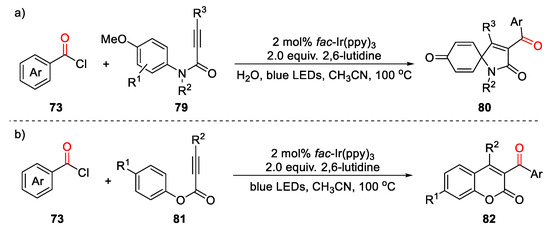
Scheme 22.
(a) Acyl radical cascade cylization of N-(p-methoxyaryl)propiolamides; (b) Cylization of alkynoates.
Recently, Xuan and Wang et al. developed an elegant photocatalytic acyl radical cyclization of 2-(allyloxy)-benzaldehydes with aroyl chlorides (Scheme 23a) [89]. The unactivated C=C bonds acted as acyl radical acceptors in this process. It was observed that the base is crucial to the reaction efficiency. 2,6-lutidine turned out to be the best base. Under the standard conditions, a series of 2-(allyloxy)-benzaldehydes reacted smoothly with aroyl chlorides to give various chroman-4-one skeletons in moderate yields. More importantly, the chromanone products could be easily converted to other important heterocycles in one-step process, such as benzofuranone and 2-phenyl-4H-thieno[3,2-c]chromene.

Scheme 23.
(a) Radical cyclization of 2-(allyloxy)-benzaldehydes with aroyl chlorides; (b) Proposed mechanism.
A series of fluorescence quenching experiments were investigated to gain insights into the reaction mechanism, which indicated that the excited state of photocatalyst was oxidatively quenched by benzoyl chloride. As described in Scheme 23b, under blue-light irradiation, benzoyl chloride is initially reduced by the photoexcited IrIII* via a single electron transfer, producing the key acyl radical intermediate (Scheme 23b). Then, the selective addition of acyl radical to the unactivated C=C bond affords a C-based radical 83-A, which then reacts with the carbonyl group to give the O-centered radical intermediate 83-B. Radical 83-B undergoes a 1,2-H migration/SET oxidation sequence to give the carbon cation intermediate 83-D, finishing the visible light photocatalytic cycle. Finally, under basic conditions, intermediate 83-D proceeds a deprotonation process to give the chroman-4-one product.
5. Miscellaneous Radical Carbonylation
The single-electron oxidative decarboxylation of α-keto acids provides an alternative method to form acyl radicals [90,91,92]. In 2014, Lei and Lan et al. reported an interesting decarboxylative amidation of α-keto acids (Scheme 24a) [93]. One impressive feature of this transformation is that O2 worked as the oxidant. A variety of α-keto acids reacted well with anilines, furnishing the final products in generally good yields. For aliphatic amines, 5–10 equivalents of amines were required to achieve good yields. More significantly, this reaction can be further utilized in the construction of N-containing heterocycles such as benzothiazole, benzoxazole and benzimidazole. Visible light irradiation of Ru(II)-catalyst delivers the excited Ru(II)* species via metal-to-ligand charge transfer (MLCT), which is reductively quenched by an amine 86 to give intermediate 86-A. Then, O2 acts as an oxidant to regenerate the ground state of Ru(II)-catalyst along with the formation of the superoxide radical anion. The superoxide radical anion further reacts with 85-A to give radical intermediate 85-B, which undergoes a decarboxylative process to afford acyl radical 86-B. Subsequently, this acyl radical reacts with an amine to generate intermediate 86-C, which then undergoes a SET process to give the amide product. Chu et al. disclosed an interesting palladium-catalyzed decarboxylation coupling/intramolecular cyclization sequence for the formation of 4-aryl-2-quinolinone derivatives (Scheme 24b) [94]. The author further elaborated its potential applicability in the rapid synthesis of the hepatitis B virus (HBV) inhibitor in an atom economy manner.
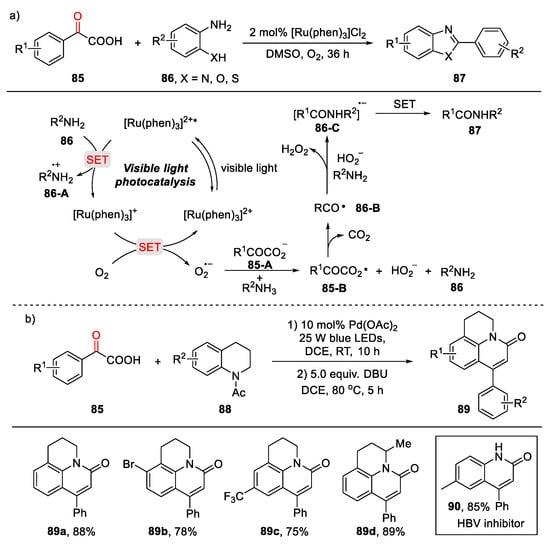
Scheme 24.
(a) Radical decarboxylative functionalization of α-keto acids; (b) Decarboxylation coupling/intramolecular cyclization sequence.
In 2016, Wang et al. demonstrated an elegant hypervalent iodine (BI–OAc)-mediated decarboxylative cyclization reaction under photocatalyst- and oxidant-free conditions (Scheme 25a) [95]. The reaction produces various oxindoles in moderate to good yields. Mechanistic studies suggested that a cascade decarbonylation, radical addition and cyclization pathway were involved in this reaction (Scheme 25b). The reaction of α-keto acid with BI–OAc results in the hypervalent iodine intermediate 91-A. Under blue LED irradiation, the homolytic cleavage of 91-A generates iodanyl radical 91-B and acyl radical 50-C. Then, the acyl radical further reacts with acrylamide 65 to give intermediate 65-B, followed by a hydrogen atom abstraction process to afford the desired product 66 along with the formation of intermediate 91-C. The intermediate 91-C may react with α-keto acid to give the hypervalent iodine intermediate 91-A for the next catalytic cycle.
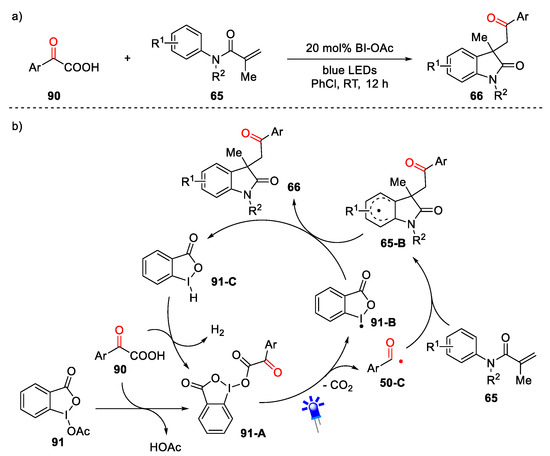
Scheme 25.
(a) Hypervalent iodine (BI–OAc)-mediated decarboxylative cyclization reaction; (b) Proposed mechanism.
Using (NH4)2S2O8 as an oxidant, Hu, Huo and Su et al. developed an eosin B-catalyzed decarboxylative cyclization of N-methacryloylbenzamides, providing a wide range of acylated isoquinolines derivatives [96]. A similar concept was applied for the formation of 2-acylindoles via a practical decarboxylative cyclization of 2-alkenylarylisocyanides with α-keto acids (Scheme 26a) [97]. Very recently, Prabhu et al. developed a decarboxylative acylation of electron-deficient heteroarenes in the presence of Na2S2O8 (Scheme 26b) [98].
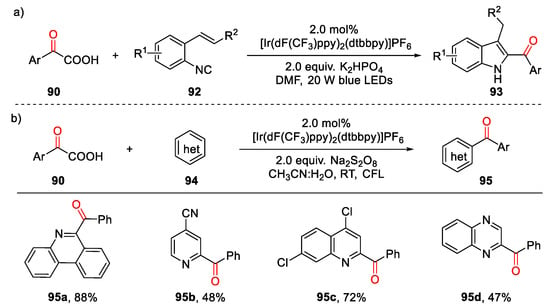
Scheme 26.
(a) Decarboxylative cyclization of 2-alkenylarylisocyanides with α-keto acids; (b) Decarboxylative acylation of electron-deficient heteroarenes.
In addition, carbamoyl radicals are important radical species that have been widely used in cascade cyclization reactions for the construction of N-containing heterocycles [99]. In 2018, Feng et al. described an oxidative decarboxylation of oxamic acids to generate carbamoyl radical species (Scheme 27a) [100]. The carbamoyl radicals then react with electron-deficient alkenes for the synthesis of a range of 3,4-dihydroquinolin-2(1H)-ones.
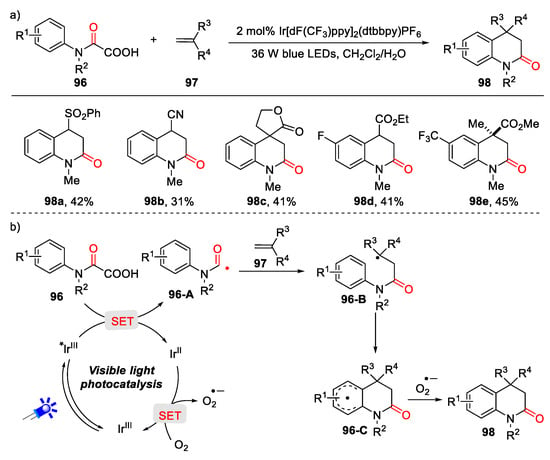
Scheme 27.
(a) Photocatalytic decarboxylative functionalization of oxamic acids; (b) Proposed mechanism.
A plausible catalytic cycle is proposed in Scheme 27b. The reaction starts with a single-electron oxidation of oxamic acid by photoexcited catalyst IrIII*, delivering the key carbamoyl radical 96-A and IrII species. Intermediate 96-A reacts with an electron-deficient alkene 97 to give C-based radical 96-B, which undergoes a rapid intramolecular cyclization to form radical 96-C. At the same time, the IrII catalyst can be oxidized by O2 to regenerate the ground state of photocatalyst, along with the formation of oxygen radical anion. Finally, the H-atom abstraction from intermediate 96-C by oxygen radical anion delivers 3,4-dihydroquinolin-2(1H)-one products.
In addition, Donald, Taylor and co-workers discovered a reductive decarboxylation process for the construction of 3,4-dihydroquinolin-2(1H)-ones (Scheme 28) [101]. In this reaction, the bench-stable and readily prepared N-hydroxyphthalimido oxamides were used as the carbamoyl radical precursors. A wide range of electron-deficient alkenes were successful radical acceptors, such as methyl methacrylate, ethyl vinyl ketone and acrylonitrile. Gratifyingly, the current reaction can be further applied for the assembly of some spirocyclic lactone lactams, which provides an important entry to biologically important spirocycles.
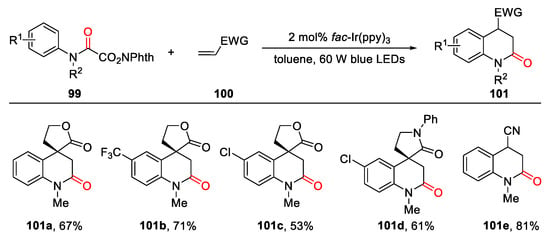
Scheme 28.
Reductive decarboxylation of N-hydroxyphthalimido oxamides.
Recently, Wu et al. demonstrated a novel C−C bond activation strategy for the generation of acyl radicals for the first time (Scheme 29) [102]. Under mild photocatalytic conditions, the β-C–C bond fragment of oxime esters leads to a range of aryl acyl radicals in high efficiency. More strikingly, the relatively unstable aliphatic acyl radicals can be successfully formed under the same catalytic system. The newly generated acyl radicals can react with diverse Michael acceptors, such as acrylamides, amines and isonitrile to furnish the desired heterocycles and other linear carbonyl compounds in good yields. A proposed mechanism is depicted in Scheme 30. Under photocatalytic conditions, oxime ester undergoes a fast SET reduction and β-C–C bond homolysis to deliver acyl radical species 102-A with the elimination of a CH3CN molecule. The selective addition of radical 102-A to acrylamide results in a C-radical 103-A, followed by an intramolecular cyclization/single-electron oxidative aromatization cascade to afford the final products and complete the photocatalytic cycle.

Scheme 29.
(a) Photocatalytic C–C bond activation of oxime esters; (b) Photocatalytic [2+2] dimerization reaction.

Scheme 30.
Proposed mechanism of C–C bond activation in oxime esters.
Surprisingly, the unexpected cyclobutanes could be obtained as the major products via a sequential SET activation and energy transfer (ET) process by using styrenes as acyl radical acceptors in DMF (Scheme 29b). The in situ generated aryl enone 107 proved to be the key intermediate, which undergoes a photocatalytic [2+2] dimerization to give the anti-cyclobutane products.
6. Conclusions
Acyl radical-meditated carbonylation has been esteemed as a powerful tool for the efficient construction of a wide range of high-value oxygen and nitrogen heterocycles. Under mild visible light photocatalytic conditions, these reactive acyl radical species can be conveniently generated from diverse acyl radical precursors. Outstanding features of these carbonylative reactions include mild conditions, good functional group tolerance, broad scope and high degree of regioselectivity. Significantly, these reactions have a promising potential in the concise synthesis of biologically active heterocycles and late-stage modification of natural products.
While significant progress emerged in this field, some important challenges remain and need to be addressed in near future. The reaction of unstable aliphatic acyl radicals is largely unexplored due to the unavoidable decarbonylation process. In addition, the radical acceptors of acyl radicals are mainly limited to electron-deficient species. We believe that the development of dual catalytic systems and design of new substrate types may provide solutions to these problems.
Author Contributions
X.-Q.H.: writing—original draft preparation; Z.-K.L.: writing—review and editing; W.-J.X.: supervision. All authors have read and agree to the published version of the manuscript.
Funding
This research was funded by the National Natural Science Foundation of China (21901258 and 21772053).
Conflicts of Interest
The authors declare no conflict of interest.
References
- Humphrey, J.M.; Chamberlin, A.R. Chemical Synthesis of Natural Product Peptides: Coupling Methods for the Incorporation of Noncoded Amino Acids into Peptides. Chem. Rev. 1997, 97, 2243–2266. [Google Scholar] [CrossRef] [PubMed]
- Zhu, L.; Ding, G.; Xie, L.; Cao, X.; Liu, J.; Lei, X.; Ma, J. Conjugated Carbonyl Compounds as High-Performance Cathode Materials for Rechargeable Batteries. Chem. Mater. 2019, 31, 8582–8612. [Google Scholar] [CrossRef]
- Mao, B.; Fañanás-Mastral, M.; Feringa, B.L. Catalytic Asymmetric Synthesis of Butenolides and Butyrolactones. Chem. Rev. 2017, 117, 10502–10566. [Google Scholar] [CrossRef] [PubMed]
- Smith, A.M.R.; Hii, K.K. Transition Metal Catalyzed Enantioselective A-Heterofunctionalization of Carbonyl Compounds. Chem. Rev. 2011, 111, 1637–1656. [Google Scholar] [CrossRef] [PubMed]
- Jang, J.; Kim, D.Y. Transition Metal-free Phosphorylation of Vinyl Azides: A Convenient Synthesis of Β-Ketophosphine Oxides. Bull. Korean Chem. Soc. 2020, 41, 370–373. [Google Scholar] [CrossRef]
- Zhu, C.; Liu, J.; Li, M.B.; Bäckvall, J.E. Palladium-catalyzed Oxidative Dehydrogenative Carbonylation Reactions Using Carbon Monoxide and Mechanistic Overviews. Chem. Soc. Rev. 2020, 49, 341–353. [Google Scholar] [CrossRef]
- Zhang, S.; Neumann, H.; Beller, M. Synthesis of α,β-unsaturated Carbonyl Compounds by Carbonylation Reactions. Chem. Soc. Rev. 2020, 49, 3187–3210. [Google Scholar] [CrossRef]
- Ryu, I. Radical Carboxylations of Iodoalkanes and Saturated Alcohols Using Carbon Monoxide. Chem. Soc. Rev. 2001, 30, 16–25. [Google Scholar] [CrossRef]
- Ryu, I. New Approaches in Radical Carbonylation Chemistry: Fluorous Applications and Designed Tandem Processes by Species-Hybridization with Anions and Transition Metal Species. Chem. Record 2002, 2, 249–258. [Google Scholar] [CrossRef]
- Sumino, S.; Fusano, A.; Fukuyama, T.; Ryu, I. Carbonylation Reactions of Alkyl Iodides through the Interplay of Carbon Radicals and Pd Catalysts. Acc. Chem. Res. 2014, 47, 1563–1574. [Google Scholar] [CrossRef]
- Peng, J.B.; Wu, F.P.; Wu, X.F. First-Row Transition-Metal-Catalyzed Carbonylative Transformations of Carbon Electrophiles. Chem. Rev. 2018, 119, 2090–2127. [Google Scholar] [CrossRef] [PubMed]
- Wu, X.F.; Fang, X.; Wu, L.; Jackstell, R.; Neumann, H.; Beller, M. Transition-Metal-Catalyzed Carbonylation Reactions of Olefins and Alkynes: A Personal Account. Acc. Chem. Res. 2014, 47, 1041–1053. [Google Scholar] [CrossRef] [PubMed]
- Kunin, A.J.; Eisenberg, R. Photochemical Carbonylation of Benzene by Iridium(I) and Rhodium(I) Square-Planar Complexes. Organometallics 1988, 7, 2124–2129. [Google Scholar] [CrossRef]
- Ferguson, R.R.; Crabtree, R.H. Mercury-Photosensitized Sulfination, Hydros ulfination, and Carbonylation of Hydrocarbons: Alkane and Alkene Conversion to Sulfonic Acids, Ketones, and Aldehydes. J. Org. Chem. 1991, 56, 5503–5510. [Google Scholar] [CrossRef]
- Sakakura, T.; Sodeyama, T.; Sasaki, K.; Wada, K.; Tanaka, M. Carbonylation of Hydrocarbons via C-H Activation Catalyzed by RhCl(CO)(PMe3)2 under Irradiation. J. Am. Chem. Soc. 1990, 112, 7221–7229. [Google Scholar] [CrossRef]
- Jaynes, B.S.; Hill, C.L. Radical Carbonylation of Alkanes via Polyoxotungstate Photocatalysis. J. Am. Chem. Soc. 1995, 117, 4704–4705. [Google Scholar] [CrossRef]
- Pitzer, L.; Sandfort, F.; Strieth-Kalthoff, F.; Glorius, F. Carbonyl–Olefin Cross-Metathesis Through a Visible-Light-Induced 1,3-Diol Formation and Fragmentation Sequence. Angew. Chem. Int. Ed. 2018, 57, 16219–16223. [Google Scholar] [CrossRef]
- Yu, X.Y.; Zhao, Q.Q.; Chen, J.; Xiao, W.-J.; Chen, J.-R. When Light Meets Nitrogen-Centered Radicals: From Reagents to Catalysts. Acc. Chem. Res. 2020, 53, 1066–1083. [Google Scholar] [CrossRef]
- Festa, A.A.; Voskressensky, L.G.; Van der Eycken, E.V. Visible Light-mediated Chemistry of Indoles and Related Heterocycles. Chem. Soc. Rev. 2019, 48, 4401–4423. [Google Scholar] [CrossRef]
- Silvi, M.; Melchiorre, P. Enhancing the Potential of Enantioselective Organocatalysis with Light. Nature 2018, 554, 41–49. [Google Scholar] [CrossRef]
- Li, W.; Xu, W.; Xie, J.; Yu, S.; Zhu, C. Distal Radical Migration Strategy: An Emerging Synthetic Means. Chem. Soc. Rev. 2018, 47, 654–667. [Google Scholar] [CrossRef]
- Kärkäs, M.D.; Porco, J.A.; Stephenson, C.R.J. Photochemical Approaches to Complex Chemotypes: Applications in Natural Product Synthesis. Chem. Rev. 2016, 116, 9683–9747. [Google Scholar] [CrossRef] [PubMed]
- Skubi, K.L.; Blum, T.R.; Yoon, T.P. Dual Catalysis Strategies in Photochemical Synthesis. Chem. Rev. 2016, 116, 10035–10074. [Google Scholar] [CrossRef]
- Prier, C.K.; Rankic, D.A.; MacMillan, D.W.C. Visible Light Photoredox Catalysis with Transition Metal Complexes: Applications in Organic Synthesis. Chem. Rev. 2013, 113, 5322–5363. [Google Scholar] [CrossRef] [PubMed]
- Fu, M.C.; Shang, R.; Zhao, B.; Wang, B.; Fu, Y. Photocatalytic Decarboxylative Alkylations Mediated by Triphenylphosphine and Sodium Iodide. Science 2019, 363, 1429–1434. [Google Scholar] [CrossRef] [PubMed]
- Strieth-Kalthoff, F.; James, M.J.; Teders, M.; Pitzer, L.; Glorius, F. Energy Transfer Catalysis Mediated by Visible Light: Principles, Applications, Directions. Chem. Soc. Rev. 2018, 47, 7190–7202. [Google Scholar] [CrossRef] [PubMed]
- Yi, H.; Zhang, G.; Wang, H.; Huang, Z.; Wang, J.; Singh, A.K.; Lei, A. Recent Advances in Radical C–H Activation/Radical Cross-Coupling. Chem. Rev. 2017, 117, 9016–9085. [Google Scholar] [CrossRef] [PubMed]
- Qiu, G.; Lai, L.; Cheng, J.; Wu, J. Recent Advances in the Sulfonylation of Alkenes with the Insertion of Sulfur Dioxide via Radical Reactions. Chem. Commun. 2018, 54, 10405–10414. [Google Scholar] [CrossRef]
- Chen, J.-R.; Hu, X.-Q.; Lu, L.-Q.; Xiao, W.-J. Visible Light Photoredox-controlled Reactions of N-radicals and Radical Ions. Chem. Soc. Rev. 2016, 45, 2044–2056. [Google Scholar] [CrossRef]
- Chen, J.-R.; Hu, X.-Q.; Lu, L.-Q.; Xiao, W.-J. Exploration of Visible-Light Photocatalysis in Heterocycle Synthesis and Functionalization: Reaction Design and Beyond. Acc. Chem. Res. 2016, 49, 1911–1923. [Google Scholar] [CrossRef]
- Banerjee, A.; Lei, Z.; Ngai, M.Y. Acyl Radical Chemistry via Visible-Light Photoredox Catalysis. Synthesis 2018, 51, 303–333. [Google Scholar] [PubMed]
- Zhao, S.; Mankad, N.P. Metal-catalysed Radical Carbonylation Reactions. Catal. Sci. Technol. 2019, 9, 3603–3613. [Google Scholar] [CrossRef]
- Matsubara, H.; Kawamoto, T.; Fukuyama, T.; Ryu, I. Applications of Radical Carbonylation and Amine Addition Chemistry: 1,4-Hydrogen Transfer of 1-Hydroxylallyl Radicals. Acc. Chem. Res. 2018, 51, 2023–2035. [Google Scholar] [CrossRef]
- Peng, J.B.; Geng, H.Q.; Wu, X.F. The Chemistry of CO: Carbonylation. Chem 2019, 5, 526–552. [Google Scholar] [CrossRef]
- Zhang, H.; Shi, R.; Ding, A.; Lu, L.; Chen, B.; Lei, A. Transition-Metal-Free Alkoxycarbonylation of Aryl Halides. Angew. Chem. Int. Ed. 2012, 51, 12542–12545. [Google Scholar] [CrossRef]
- Guo, W.; Lu, L.-Q.; Wang, Y.; Wang, Y.N.; Chen, J.-R.; Xiao, W.-J. Metal-Free, Room-Temperature, Radical Alkoxycarbonylation of Aryldiazonium Salts Through Visible-Light Photoredox Catalysis. Angew. Chem. Int. Ed. 2014, 54, 2265–2269. [Google Scholar] [CrossRef] [PubMed]
- Majek, M.; Jacobi von Wangelin, A. Metal-Free Carbonylations by Photoredox Catalysis. Angew. Chem. Int. Ed. 2014, 54, 2270–2274. [Google Scholar] [CrossRef]
- Gu, L.; Jin, C.; Liu, J. Metal-free, Visible-light-mediated Transformation of Aryl Diazonium Salts and (hetero)arenes: An Efficient Route to Aryl Ketones. Green Chem. 2015, 17, 3733–3736. [Google Scholar] [CrossRef]
- Zhang, H.T.; Gu, L.J.; Huang, X.Z.; Wang, R.; Jin, C.; Li, G.P. Synthesis of Indol-3-yl Aryl Ketones Through Visible-light-mediated Carbonylation. Chin. Chem. Lett. 2016, 27, 256–260. [Google Scholar] [CrossRef]
- Li, X.; Liang, D.; Huang, W.; Zhou, H.; Li, Z.; Wang, B.; Ma, Y.; Wang, H. Visible Light-induced Carbonylation of Indoles with Arylsulfonyl Chlorides and CO. Tetrahedron 2016, 72, 8442–8448. [Google Scholar] [CrossRef]
- Micic, N.; Polyzos, A. Radical Carbonylation Mediated by Continuous-Flow Visible-Light Photocatalysis: Access to 2,3-Dihydrobenzofurans. Org. Lett. 2018, 20, 4663–4666. [Google Scholar] [CrossRef]
- Zhou, Q.-Q.; Guo, W.; Ding, W.; Wu, X.; Chen, X.; Lu, L.-Q.; Xiao, W.-J. Decarboxylative Alkynylation and Carbonylative Alkynylation of Carboxylic Acids Enabled by Visible-Light Photoredox Catalysis. Angew. Chem. Int. Ed. 2015, 54, 11196–11199. [Google Scholar] [CrossRef] [PubMed]
- Jiang, X.; Zhang, M.; Xiong, W.; Lu, L.-Q.; Xiao, W.-J. Deaminative (Carbonylative) Alkyl-Heck-type Reactions Enabled by Photocatalytic C−N Bond Activation. Angew. Chem. Int. Ed. 2019, 58, 2402–2406. [Google Scholar] [CrossRef] [PubMed]
- Basch, C.H.; Liao, J.; Xu, J.; Piane, J.J.; Watson, M.P. Harnessing Alkyl Amines as Electrophiles for Nickel-Catalyzed Cross Couplings via C–N Bond Activation. J. Am. Chem. Soc. 2017, 139, 5313–5316. [Google Scholar] [CrossRef] [PubMed]
- Yue, H.; Zhu, C.; Shen, L.; Geng, Q.; Hock, K.J.; Yuan, T.; Cavallo, L.; Rueping, M. Nickel-catalyzed C–N Bond Activation: Activated Primary Amines as Alkylating Reagents in Reductive Cross-coupling. Chem. Sci. 2019, 10, 4430–4435. [Google Scholar] [CrossRef]
- Wu, J.; He, L.; Noble, A.; Aggarwal, V.K. Photoinduced Deaminative Borylation of Alkylamines. J. Am. Chem. Soc. 2018, 140, 10700–10704. [Google Scholar] [CrossRef] [PubMed]
- Lu, B.; Cheng, Y.; Chen, L.Y.; Chen, J.-R.; Xiao, W.-J. Photoinduced Copper-Catalyzed Radical Aminocarbonylation of Cycloketone Oxime Esters. ACS Catal. 2019, 9, 8159–8164. [Google Scholar] [CrossRef]
- Torres, G.M.; Liu, Y.; Arndtsen, B.A. A Dual Light-driven Palladium Catalyst: Breaking the Barriers in Carbonylation Reactions. Science 2020, 368, 318–323. [Google Scholar] [CrossRef]
- Cartier, A.; Levernier, E.; Dhimane, A.; Fukuyama, T.; Ollivier, C.; Ryu, I.; Fensterbank, L. Synthesis of Aliphatic Amides Through a Photoredox Catalyzed Radical Carbonylation Involving Organosilicates as Alkyl Radical Precursors. Adv. Synth. Catal. 2020, 362, 2254–2259. [Google Scholar] [CrossRef]
- Liu, K.; Zou, M.; Lei, A. Aerobic Oxidative Carbonylation of Enamides by Merging Palladium with Photoredox Catalysis. J. Org. Chem. 2016, 81, 7088–7092. [Google Scholar] [CrossRef]
- Chatgilialoglu, C.; Crich, D.; Komatsu, M.; Ryu, I. Chemistry of Acyl Radicals. Chem. Rev. 1999, 99, 1991–2070. [Google Scholar] [CrossRef] [PubMed]
- Cheng, P.; Qing, Z.; Liu, S.; Liu, W.; Xie, H.; Zeng, J. Regiospecific Minisci Acylation of Phenanthridine via Thermolysis or Photolysis. Tetrahedron Lett. 2014, 55, 6647–6651. [Google Scholar] [CrossRef]
- Capaldo, L.; Ravelli, D. Hydrogen Atom Transfer (HAT): A Versatile Strategy for Substrate Activation in Photocatalyzed Organic Synthesis. Eur. J. Org. Chem. 2017, 2017, 2056–2071. [Google Scholar] [CrossRef] [PubMed]
- Li, J.; Wang, D.Z. Visible-Light-Promoted Photoredox Syntheses of α, β-Epoxy Ketones from Styrenes and Benzaldehydes Under Alkaline Conditions. Org. Lett. 2015, 17, 5260–5263. [Google Scholar] [CrossRef]
- de Souza, G.F.P.; Bonacin, J.A.; Salles, A.G., Jr. Visible-Light-Driven Epoxyacylation and Hydroacylation of Olefins Using Methylene Blue/Persulfate System in Water. J. Org. Chem. 2018, 83, 8331–8340. [Google Scholar] [CrossRef]
- Voutyritsa, E.; Kokotos, C.G. Green Metal-Free Photochemical Hydroacylation of Unactivated Olefins. Angew. Chem. Int. Ed. 2020, 59, 1735–1741. [Google Scholar] [CrossRef]
- Zhao, X.; Li, B.; Xia, W. Visible-Light-Promoted Photocatalyst-Free Hydroacylation and Diacylation of Alkenes Tuned by NiCl2·DME. Org. Lett. 2020, 22, 1056–1061. [Google Scholar] [CrossRef]
- Goti, G.; Bieszczad, B.; Vega-Peñaloza, A.; Melchiorre, P. Stereocontrolled Synthesis of 1,4-Dicarbonyl Compounds by Photochemical Organocatalytic Acyl Radical Addition to Enals. Angew. Chem. Int. Ed. 2019, 58, 1213–1217. [Google Scholar] [CrossRef]
- Jung, S.; Kim, J.; Hong, S. Visible Light-Promoted Synthesis of Spiroepoxy Chromanone Derivatives via a Tandem Oxidation/Radical Cyclization/Epoxidation Process. Adv. Synth. Catal. 2017, 359, 3945–3949. [Google Scholar] [CrossRef]
- Kawaai, K.; Yamaguchi, T.; Yamaguchi, E.; Endo, S.; Tada, N.; Ikari, A.; Itoh, A. Photoinduced Generation of Acyl Radicals from Simple Aldehydes, Access to 3-Acyl-4-arylcoumarin Derivatives, and Evaluation of Their Antiandrogenic Activities. J. Org. Chem. 2018, 83, 1988–1996. [Google Scholar] [CrossRef]
- Lux, M.; Klussmann, M. Additions of Aldehyde-Derived Radicals and Nucleophilic N-Alkylindoles to Styrenes by Photoredox Catalysis. Org. Lett. 2020, 22, 3697–3701. [Google Scholar] [CrossRef]
- Zhang, Y.; Ji, P.; Dong, Y.; Wei, Y.; Wang, W. Deuteration of Formyl Groups via a Catalytic Radical H/D Exchange Approach. ACS Catal. 2020, 10, 2226–2230. [Google Scholar] [CrossRef]
- Ackermann, L. Carboxylate-Assisted Transition-Metal-Catalyzed C−H Bond Functionalizations: Mechanism and Scope. Chem. Rev. 2011, 111, 1315–1345. [Google Scholar] [CrossRef] [PubMed]
- Gooßen, L.; Rodríguez, N.; Gooßen, K. Carboxylic Acids as Substrates in Homogeneous Catalysis. Angew. Chem. Int. Ed. 2008, 47, 3100–3120. [Google Scholar] [CrossRef]
- Font, M.; Quibell, J.M.; Perry, G.J.P.; Larrosa, I. The Use of Carboxylic Acids as Traceless Directing Groups for Regioselective C–H Bond Functionalisation. Chem. Commun. 2017, 53, 5584–5597. [Google Scholar] [CrossRef] [PubMed]
- Hu, X.-Q.; Liu, Z.-K.; Hou, Y.-X.; Gao, Y. Single Electron Activation of Aryl Carboxylic Acids. iScience 2020, 23, 101266. [Google Scholar] [CrossRef]
- Zhang, M.; Xie, J.; Zhu, C. A General Deoxygenation Approach for Synthesis of Ketones from Aromatic Carboxylic Acids and Alkenes. Nat. Commun. 2018, 9, 3517. [Google Scholar] [CrossRef]
- Stache, E.E.; Ertel, A.B.; Rovis, T.; Doyle, A.G. Generation of Phosphoranyl Radicals via Photoredox Catalysis Enables Voltage–Independent Activation of Strong C–O Bonds. ACS Catal. 2018, 8, 11134–11139. [Google Scholar] [CrossRef]
- Zhang, M.; Yuan, X.A.; Zhu, C.; Xie, J. Deoxygenative Deuteration of Carboxylic Acids with D2O. Angew. Chem. Int. Ed. 2018, 58, 312–316. [Google Scholar] [CrossRef]
- Ruzi, R.; Ma, J.; Yuan, X.; Wang, W.; Wang, S.; Zhang, M.; Dai, J.; Xie, J.; Zhu, C. Deoxygenative Arylation of Carboxylic Acids by Aryl Migration. Chem. Eur. J. 2019, 25, 12724–12729. [Google Scholar] [CrossRef]
- Jiang, H.; Mao, G.; Wu, H.; An, Q.; Zuo, M.; Guo, W.; Xu, C.; Sun, Z.; Chu, W. Synthesis of Dibenzocycloketones by Acyl Radical Cyclization from Aromatic Carboxylic Acids Using Methylene Blue as a Photocatalyst. Green Chem. 2019, 21, 5368–5373. [Google Scholar] [CrossRef]
- Martinez Alvarado, J.I.; Ertel, A.B.; Stegner, A.; Stache, E.E.; Doyle, A.G. Direct Use of Carboxylic Acids in the Photocatalytic Hydroacylation of Styrenes To Generate Dialkyl Ketones. Org. Lett. 2019, 21, 9940–9944. [Google Scholar] [CrossRef] [PubMed]
- Guo, Y.Q.; Wang, R.; Song, H.; Liu, Y.; Wang, Q. Visible-Light-Induced Deoxygenation/Defluorination Protocol for Synthesis of γ,γ-Difluoroallylic Ketones. Org. Lett. 2020, 22, 709–713. [Google Scholar] [CrossRef] [PubMed]
- Bergonzini, G.; Cassani, C.; Wallentin, C.J. Acyl Radicals from Aromatic Carboxylic Acids by Means of Visible-Light Photoredox Catalysis. Angew. Chem. Int. Ed. 2015, 54, 14066–14069. [Google Scholar] [CrossRef] [PubMed]
- Pettersson, F.; Bergonzini, G.; Cassani, C.; Wallentin, C.J. Redox-Neutral Dual Functionalization of Electron-Deficient Alkenes. Chem. Eur. J. 2017, 23, 7444–7447. [Google Scholar] [CrossRef] [PubMed]
- Zhang, M.; Ruzi, R.; Xi, J.; Li, N.; Wu, Z.; Li, W.; Yu, S.; Zhu, C. Photoredox-Catalyzed Hydroacylation of Olefins Employing Carboxylic Acids and Hydrosilanes. Org. Lett. 2017, 19, 3430–3433. [Google Scholar] [CrossRef] [PubMed]
- Zhang, M.; Li, N.; Tao, X.; Ruzi, R.; Yu, S.; Zhu, C. Selective Reduction of Carboxylic Acids to Aldehydes with Hydrosilane via Photoredox Catalysis. Chem. Commun. 2017, 53, 10228–10231. [Google Scholar] [CrossRef] [PubMed]
- Ruzi, R.; Zhang, M.; Ablajan, K.; Zhu, C. Photoredox-Catalyzed Deoxygenative Intramolecular Acylation of Biarylcarboxylic Acids: Access to Fluorenones. J. Org. Chem. 2017, 82, 12834–12839. [Google Scholar] [CrossRef]
- Bergonzini, G.; Cassani, C.; Lorimer-Olsson, H.; Hörberg, J.; Wallentin, C.J. Visible-Light-Mediated Photocatalytic Difunctionalization of Olefins by Radical Acylarylation and Tandem Acylation/Semipinacol Rearrangement. Chem. Eur. J. 2016, 22, 3292–3295. [Google Scholar] [CrossRef]
- Ociepa, M.; Baka, O.; Narodowiec, J.; Gryko, D. Light-Driven Vitamin B12-Catalysed Generation of Acyl Radicals from 2-S-Pyridyl Thioesters. Adv. Synth. Catal. 2017, 359, 3560–3565. [Google Scholar] [CrossRef]
- Norman, A.R.; Yousif, M.N.; McErlean, C.S.P. Photoredox-catalyzed Indirect Acyl Radical Generation from Thioesters. Org. Chem. Front. 2018, 5, 3267–3298. [Google Scholar] [CrossRef]
- Xu, S.M.; Chen, J.Q.; Liu, D.; Bao, Y.; Liang, Y.M.; Xu, P.F. Aroyl Chlorides as Novel Acyl Radical Precursors via Visible-light Photoredox Catalysis. Org. Chem. Front. 2017, 4, 1331–1335. [Google Scholar] [CrossRef]
- Li, C.G.; Xu, G.Q.; Xu, P.F. Synthesis of Fused Pyran Derivatives via Visible-Light-Induced Cascade Cyclization of 1,7-Enynes with Acyl Chlorides. Org. Lett. 2017, 19, 512–515. [Google Scholar] [CrossRef] [PubMed]
- Zhao, Q.S.; Xu, G.Q.; Liang, H.; Wang, Z.Y.; Xu, P.F. Aroylchlorination of 1,6-Dienes via a Photoredox Catalytic Atom-Transfer Radical Cyclization Process. Org. Lett. 2019, 21, 8615–8619. [Google Scholar] [CrossRef] [PubMed]
- Patil, D.V.; Kim, H.Y.; Oh, K. Visible Light-Promoted Friedel–Crafts-Type Chloroacylation of Alkenes to Β-Chloroketones. Org. Lett. 2020, 22, 3018–3022. [Google Scholar] [CrossRef]
- Liu, Y.; Wang, Q.L.; Zhou, C.S.; Xiong, B.Q.; Zhang, P.L.; Yang, C.A.; Tang, K.W. Visible-Light-Mediated Ipso-Carboacylation of Alkynes: Synthesis of 3-Acylspiro[4,5]trienones from N-(p-Methoxyaryl)propiolamides and Acyl Chlorides. J. Org. Chem. 2018, 83, 2210–2218. [Google Scholar] [CrossRef] [PubMed]
- Liu, Y.; Wang, Q.L.; Zhou, C.S.; Xiong, B.Q.; Zhang, P.L.; Kang, S.J.; Yang, C.A.; Tang, K.W. Visible-light-mediated Cascade Difunctionalization/cyclization of Alkynoates with Acyl Chlorides for Synthesis of 3-acylcoumarins. Tetrahedron Lett. 2018, 59, 2038–2041. [Google Scholar] [CrossRef]
- Liu, Y.; Chen, Z.; Wang, Q.L.; Chen, P.; Xie, J.; Xiong, B.Q.; Zhang, P.L.; Tang, K.W. Visible Light-Catalyzed Cascade Radical Cyclization of N-Propargylindoles with Acyl Chlorides for the Synthesis of 2-Acyl-9H-pyrrolo[1,2-a]indoles. J. Org. Chem. 2020, 85, 2385–2394. [Google Scholar] [CrossRef]
- He, X.; Cai, B.; Yang, Q.; Wang, L.; Xuan, J. Visible-Light-Promoted Cascade Radical Cyclization: Synthesis of 1,4-Diketones Containing Chroman-4-One Skeletons. Chem. Asian J. 2019, 14, 3269–3273. [Google Scholar] [CrossRef]
- Wang, G.Z.; Shang, R.; Cheng, W.M.; Fu, Y. Decarboxylative 1,4-Addition of A-Oxocarboxylic Acids with Michael Acceptors Enabled by Photoredox Catalysis. Org. Lett. 2015, 17, 4830–4833. [Google Scholar] [CrossRef]
- Zhao, J.J.; Zhang, H.H.; Shen, X.; Yu, S. Enantioselective Radical Hydroacylation of Enals with A-Ketoacids Enabled by Photoredox/Amine Cocatalysis. Org. Lett. 2019, 21, 913–916. [Google Scholar] [CrossRef] [PubMed]
- Li, J.; Liu, Z.; Wu, S.; Chen, Y. Acyl Radical Smiles Rearrangement to Construct Hydroxybenzophenones by Photoredox Catalysis. Org. Lett. 2019, 21, 2077–2080. [Google Scholar] [CrossRef] [PubMed]
- Liu, J.; Liu, Q.; Yi, H.; Qin, C.; Bai, R.; Qi, X.; Lan, Y.; Lei, A. Visible-Light-Mediated Decarboxylation/Oxidative Amidation of A-Keto Acids with Amines Under Mild Reaction Conditions Using O2. Angew. Chem. Int. Ed. 2013, 53, 502–506. [Google Scholar] [CrossRef] [PubMed]
- Wang, C.; Qiao, J.; Liu, X.; Song, H.; Sun, Z.; Chu, W. Visible-Light-Induced Decarboxylation Coupling/Intramolecular Cyclization: A One-Pot Synthesis for 4-Aryl-2-quinolinone Derivatives. J. Org. Chem. 2018, 83, 1422–1430. [Google Scholar] [CrossRef]
- Ji, W.; Tan, H.; Wang, M.; Li, P.; Wang, L. Photocatalyst-free Hypervalent Iodine Reagent Catalyzed Decarboxylative Acylarylation of Acrylamides with A-oxocarboxylic Acids Driven by Visible-light Irradiation. Chem. Commun. 2016, 52, 1462–1465. [Google Scholar] [CrossRef]
- Su, Y.; Zhang, R.; Xue, W.; Liu, X.; Zhao, Y.; Wang, K.H.; Huang, D.; Huo, C.; Hu, Y. Visible-light-promoted Acyl Radical Cascade Reaction for Accessing Acylated Isoquinoline-1,3(2H,4H)-dione Derivatives. Org. Biomol. Chem. 2020, 18, 1940–1948. [Google Scholar] [CrossRef]
- Zhang, X.; Zhu, P.; Zhang, R.; Li, X.; Yao, T. Visible-Light-Induced Decarboxylative Cyclization of 2-Alkenylarylisocyanides with A-Oxocarboxylic Acids: Access to 2-Acylindoles. J. Org. Chem. 2020. [Google Scholar] [CrossRef]
- Manna, S.; Prabhu, K.R. Visible-Light-Mediated Direct Decarboxylative Acylation of Electron-Deficient Heteroarenes Using A-Ketoacids. J. Org. Chem. 2019, 84, 5067–5077. [Google Scholar] [CrossRef]
- Petersen, W.F.; Taylor, R.J.K.; Donald, J.R. Photoredox-catalyzed Procedure for Carbamoyl Radical Generation: 3,4-dihydroquinolin-2-one and Quinolin-2-one Synthesis. Org. Biomol. Chem. 2017, 15, 5831–5845. [Google Scholar] [CrossRef]
- Bai, Q.F.; Jin, C.; He, J.Y.; Feng, G. Carbamoyl Radicals via Photoredox Decarboxylation of Oxamic Acids in Aqueous Media: Access to 3,4-Dihydroquinolin-2(1H)-ones. Org. Lett. 2018, 20, 2172–2175. [Google Scholar] [CrossRef]
- Petersen, W.F.; Taylor, R.J.K.; Donald, J.R. Photoredox-Catalyzed Reductive Carbamoyl Radical Generation: A Redox-Neutral Intermolecular Addition–Cyclization Approach to Functionalized 3,4-Dihydroquinolin-2-ones. Org. Lett. 2017, 19, 874–877. [Google Scholar] [CrossRef] [PubMed]
- Fan, X.; Lei, T.; Chen, B.; Tung, C.H.; Wu, L.Z. Photocatalytic C–C Bond Activation of Oxime Ester for Acyl Radical Generation and Application. Org. Lett. 2019, 21, 4153–4158. [Google Scholar] [CrossRef] [PubMed]
© 2020 by the authors. Licensee MDPI, Basel, Switzerland. This article is an open access article distributed under the terms and conditions of the Creative Commons Attribution (CC BY) license (http://creativecommons.org/licenses/by/4.0/).